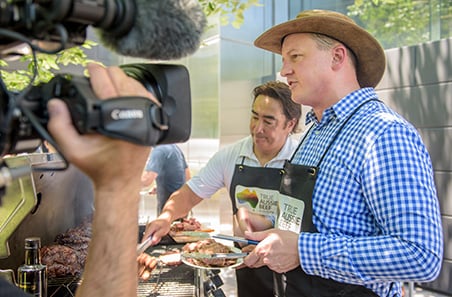Challenges to Aussie beef’s market dominance in North Asia
 Casting a spotlight on North Asia, MLA’s International Business Manager for Japan and Korea, Andrew Cox, talks about how Australian beef can retain its number one position in this market.
Casting a spotlight on North Asia, MLA’s International Business Manager for Japan and Korea, Andrew Cox, talks about how Australian beef can retain its number one position in this market.
In 2016, Japan reclaimed the title of Australia’s largest beef export market while volumes to South Korea set a second successive record, making it the third largest export destination for our beef.
A total of 264,325 tonnes shipped weight (swt) of Australian beef was exported to Japan in 2016. A record 179,854 tonnes swt was exported to South Korea in 2016, representing an 8% lift from the record set in 2015.
While these topline figures are encouraging, they belie the fact that Australian beef sales in the region are under pressure on a number of fronts.
Firstly, unlike developing markets, we cannot simply rely on population or economic growth to drive sales. Both countries rank amongst the lowest in population growth, with Japan now officially shrinking from its peak of 130 million residents and Korea’s 50 million set to follow from sometime next decade. Both nations are already highly developed, wealthy nations, with conservative future growth forecasts.
Secondly, we are under increasing pressure from our competitors. In the last three years Australia has exported 1.36 million tonnes swt of beef to Japan and Korea, worth over $8.89 billion. This is significantly more than our nearest competitor, United States beef, with 1.05 million tonnes swt valued at $7.23 billion.
But Australia’s position as the market share leader is relatively new. Before BSE – or mad cow disease – was found in the American cattle herd in 2003, Australia’s market share was a distant second to US beef in both markets. With the resulting US suspension, Australian beef assumed a near monopoly on imported beef sales in both markets. Once the market slowly reopened for US beef, our superior safety reputation helped us stay on top, with the added benefit of economic partnership agreements with both nations.
However, US beef marketing authorities have publicly targeted Japan and Korea, traditionally their largest and most valuable export markets, with heavy investment in marketing promotions aimed to wrest back share from Australia. In the latter half of 2016, with much increased supply relative to Australia, US beef was often trading at a steep discount to Australian beef, and our market share began to fall.
US beef is not the only competitor for ‘share of stomach’. Both Japan and Korea are understandably proud of their own premium, highly marbled domestic beef. And in supermarkets, imported beef cuts are usually ranged next to pork cuts, which offer a far cheaper alternative ingredient in the same popular family meals.
So how do we stay on top? Is it even possible against the world’s biggest beef producer, with six times our production? And, is it even necessary, given the stronger protein demand growth coming from developing markets?
Firstly, yes we need to aggressively defend our market share in Japan and Korea. These are large, valuable beef markets with high incomes. They’re also markets with various culturally significant beef dishes, and with buyers that place a high value on the Aussie beef brand – value built slowly over many years. And markets that do offer growth opportunities, if we continue to look for ways to fit consumer trends.
Importantly, Japan and Korea are also markets where our beef is generally consumer facing and sold by country of origin - meaning the consumer is more likely to see True Aussie branding. In both markets, country of origin has become the number one driver of choice in supermarkets, ahead of usual suspects such as price, meat colour and pack size. For these reasons, continued whole of industry investment in country of origin brand promotion makes strategic sense.
Recently, we conducted in-depth market research with consumers in South Korea’s capital city, Seoul. Again and again I heard consumers mention the same things. Compared to others, Australian beef is trusted, Australian beef is natural, Australian beef is versatile, Australian beef is familiar, and Australian beef is tasty. Some of our competitors can claim one or another of these attributes, but none offer the whole package like we do.
These are highly valuable attitudes that need to be continually reinforced by consumer promotions and industry communication activities aimed at growing long-term loyalty behind ‘Brand Australia’.
That way, even when a retailer, restaurant chain or wholesaler can make significantly more profit by switching to a competitor, they are reluctant to do so for fear of losing loyal customers themselves.
Lastly, of course, our industry needs to stay on top of what makes consumers tick in all our global markets. Ultimately, it is competition amongst customers for the available Australian beef that drives our meat and livestock prices.
More information
Andrew Cox
MLA International Business Manager – Japan and Korea
acox@mla.com.au



